-
Posts
1,262 -
Joined
-
Last visited
Content Type
Profiles
Forums
Events
Store
Posts posted by Andrej Stancak
-
-
Cheers, Andrej. You can see that if the top landing was deeper than you have calculated, it could make a huge difference to where PP or BWF could be.
Dear Ray:
the top landing was tiny. You can best check it in the famous photograph in which the doorway is shown from the back through the glass door, I can upload the picture if you would wish.The WC chart showing the top landing as deep is wrong, and I would not draw any conclusions from this drawing.
So you guessed the depth of the landing from a photo?
Ray: not from one photograph but from several photographs. I certainly checked whether my model would show the same proportions as seen in the back-through photograph. Further, the top landing had to fit all the parts of the doorway, and the whole doorway model had to fit the Google doorway. The top landing does not exist in its original form anymore to verify my estimates. However, if my model would be wrong in some essential aspect, I would simply not be able to reproduce a photographed scene, such as Darnell's scene. The fact that my model could be aligned with the real photograph suggests that the model was sound.
The value of my model is that it allows to generate hypotheses how things could have happen, and to suggest and initially test the most plausible hypotheses. Without making a model and reconstructing Darnell's scene it would be difficult to make up the one-foot-down-one-foot-up possibility. However, a model is only a model, it is not the reality. Therefore, every model including my model needs to be tested in reality. This would entail posing one 6' and one 5'9'' man at spots which my model predicts (I could provide detailed pictures and coordinates) and shooting the doorway using different focal lengths from Darnell's viewpoint. It does not matter so much that the back of the doorway has been rebuilt.
I did my bit...
-
Cheers, Andrej. You can see that if the top landing was deeper than you have calculated, it could make a huge difference to where PP or BWF could be.
Dear Ray:
the top landing was tiny. You can best check it in the famous photograph in which the doorway is shown from the back through the glass door, I can upload the picture if you would wish.The WC chart showing the top landing as deep is wrong, and I would not draw any conclusions from this drawing.
How wide was the door that opened out on to the landing?
I guess it was just about 4'.
The middle panel was 3'4'' 9/16 in my model.
-
Cheers, Andrej. You can see that if the top landing was deeper than you have calculated, it could make a huge difference to where PP or BWF could be.
Dear Ray:
the top landing was tiny. You can best check it in the famous photograph in which the doorway is shown from the back through the glass door, I can upload the picture if you would wish.The WC chart showing the top landing as deep is wrong, and I would not draw any conclusions from this drawing.
-
Dear Ray:
the sources for my model were numerous photographs and films of the doorway and the Depository, mostly those available from the JFK Assassination Gallery and Mary Ferrell website. I have also analysed the WC drawing but did not find it too useful. It took me about 4 months to create and check the model. I am not sure I would be able to undertake this project once more...
-
Dear Ray:
the front-to-back dimension of the top landing in my model is 3'6'' 15.
-
Andrej, why have you shown part of the hand in sunlight when the Darnell photo doesn't show that?
Dear Ray:
I think that Prayer Man's right hand was hit by the sun light on a very small spot, and due to natural blurring of the picture (distance, resolution, film material) this small bright spot got averaged with the darker part of the rest of his hand, causing the hand looking brighter than the forearm.
It is possible to bend Prayer's Man right hand so that it does not create an angle after moving his left forearm further away from the right hand. Prayer Man would stay on the same spot as you can see him now and the adjustment in the wrist joint would cause his right hand being also in the shadow. I am leaving things as they are though because I believe there was some light reflection from Prayer Man's right hand. The difference between the hand reflecting the sun and not is maybe one inch displacement of the hand, not of the whole Prayer Man.
-
Finally, let us approximate Frazier's location during the shooting by checking his visibility in Altgens6. Should Frazier stand on the same spot as we see him in Darnell's picture, he would actually be partly visible in Altgens6, which is demonstrated in the first figure. The blue plane stands for Altgens6 plane. Please note that a part of Frazier's left shoulder and arm are in the visible space.

Frazier was moved slightly towards the glass door in such a way that his left arm just does not touch the Altgens6 plane, which is illustrated in the next picture.
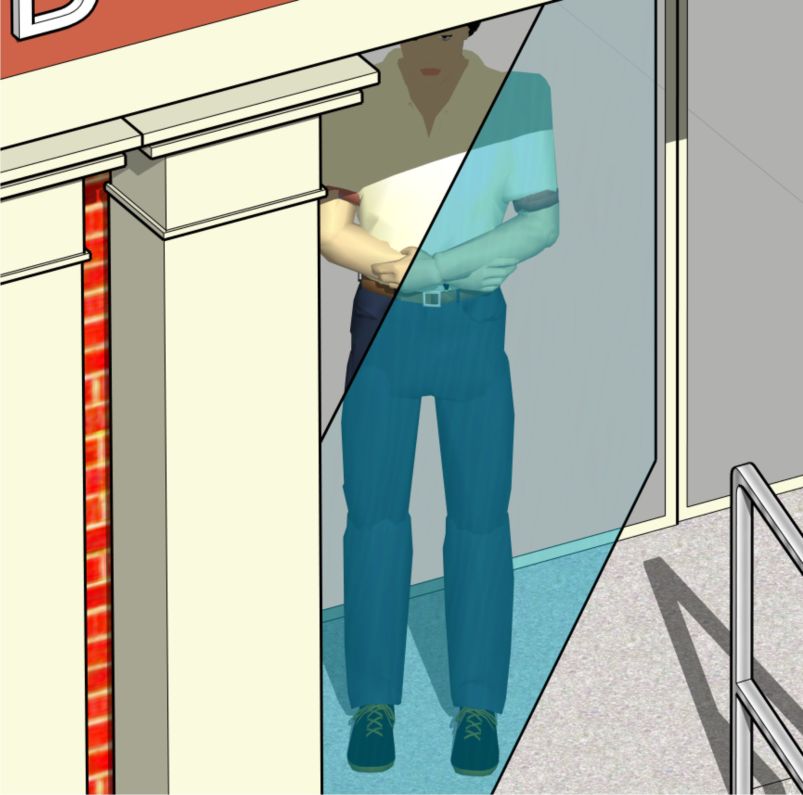
So, we have two Fraziers. The one in the front would be visible in Altgens6, and the one behind just not.

And here is the front view of Darnell's scene adjusted to ensure Frazier's invisibility in Altgens6.

-
To illustrate the situation in the doorway based on my 3D reconstruction, I have prepared few more pictures.
A detailed view of Darnell's scene:

Detail in front view:

Full front view:
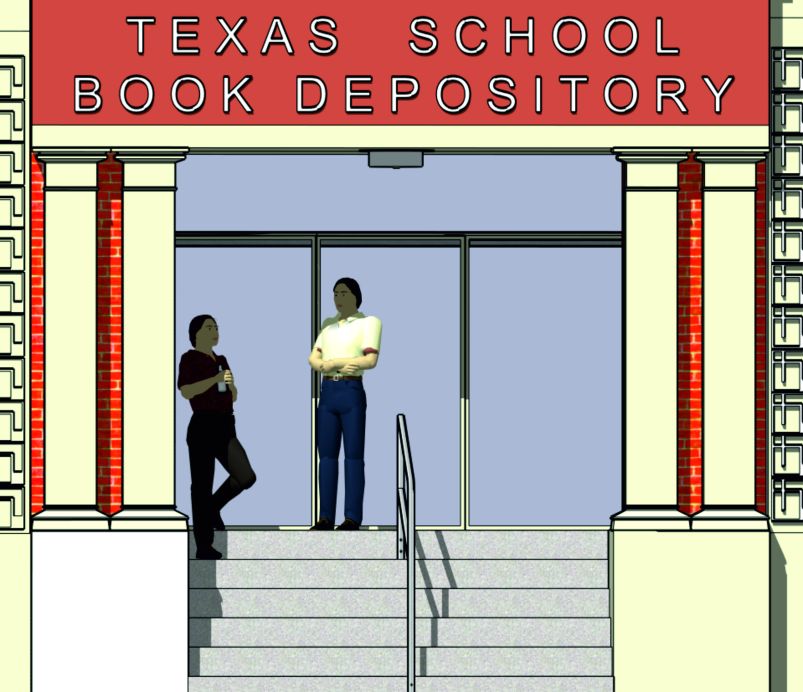
Back view of Frazier and Prayer Man:

-
Andrej,
You are making a systemic error, presuming that your one-foot-down-one-foot-up graphic represents the 5'9" Oswald. The step is 7-1/2" high, so to conclude that your graphic represents the 5'9" Oswald, you are required to demonstrate a relation between Frazier & Oswald that shows the Darnell "Oswald" is only 5' 1-1/2" above the landing.
Not just a relation between PrayerMan and his vertical strip, and between Frazier and his vertical strip. You are claiming "Oswald" is only 5' 1-1/2" above the landing, with no basis for comparison- just your say-so.
Would you not object if I claimed "Oswald" was one step down, and actually 6' 4-1/2"?
Dear Richard,
thanks for your comments. I hope to be able to clarify few points. First, I can confirm both measures you mention in your post, the height of the step and the 5'1'' distance from the top landing to Frazier's neck line in Darnell's scene. However, this latter figure is relative and depends both on the relative heights of the two people (minus the height of the step) and also on the view angle. The distance of 5'1'' would not hold if Darnell's view angle (elevation) would be different. The figure below illustrates the problem. It shows Prayer Man and Frazier as in Darnell scene from the front view. In A, the view angle is from the bottom. The line crossing Frazier's left shoulder and neck crosses Prayer Man's eyes. The heads of both figures overlap with the horizontal rail. In B, the view angle is also from the bottom but less sharp than in A and therefore the heads of these two people no more overlap with the horizontal rail. In C, the view angle is flat and the line crossing Frazier's shoulder now aligns with the top of Prayer Man's head. In D, the view is from the above the doorway and the line crossing Frazier's shoulder is above Prayer Man's head.

Thus, the figure of 5'1'' has no specific significance and it is tightly related to the view angle applied by Darnell and his camera. The only chance to verify the location of Prayer Man in the 3D model against Darnell's picture is to co-register both doorways in 2D, which I have done and showed using the vertical blue lines and the yellow rectangles (to show that both doorways also fit vertically).
As per your last comment about Prayer Man standing actually two steps down and the alignment with Frazier's neck line being compensated by increasing his height to 6'4'' (194 cm), here I would certainly object. Such a giant Prayer Man could not satisfy all the stringent constrains derived from Darnell's picture. The giant Prayer Man could reach with his head to Frazier's neck line, he would also be aligned with the corner rail, however, his trunk and face would be exposed to the sun which we know was not true. Well, I can push this giant man closer to the western wall to escape being hit by the sun. Unfortunately, in such a case his body would no more align with the corner rail of the door frame (bottom panel in the figure below).
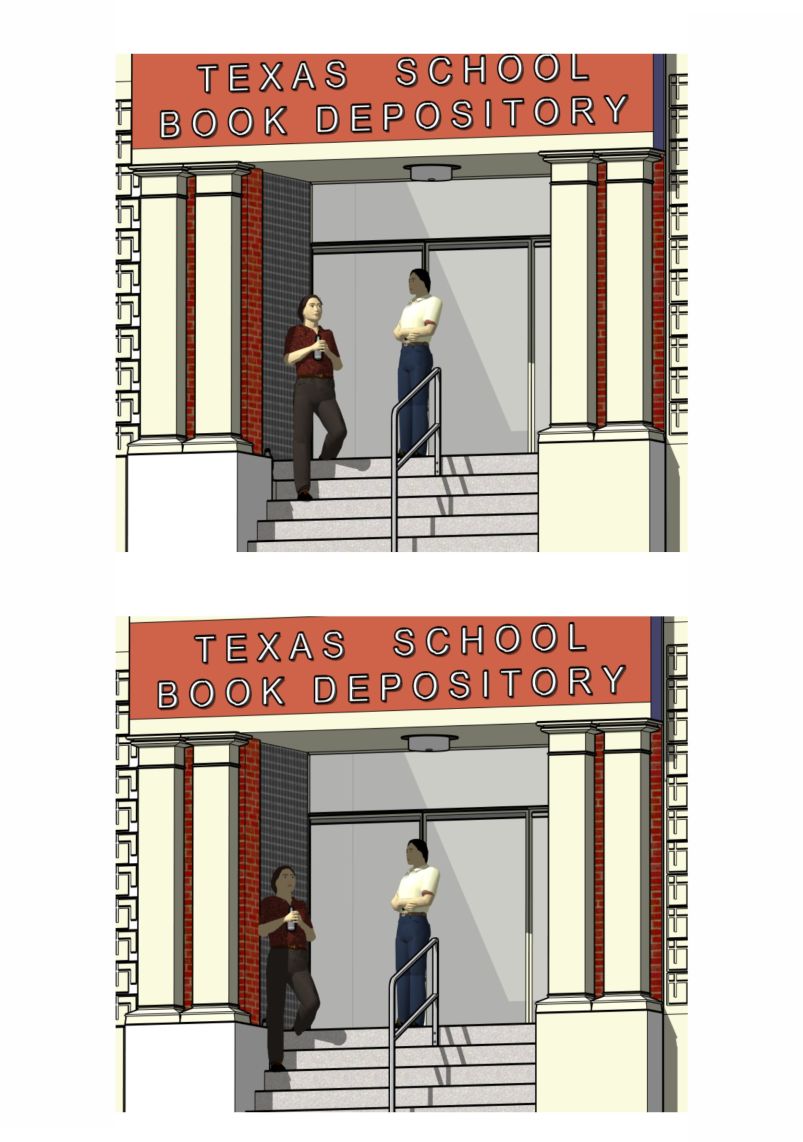
I hope I was able to address all your concerns. Once we apply some empirical assumptions (derived from Darnell's picture), there is not much freedom in how to fit Prayer Man into the doorway. Prayer Man could not be on the top platform with both his feet, and he could not be two steps down (a giant Prayer Man), he could only be on the first step with only one foot. I can also prepare some views of Prayer Woman of 5'3''. As Prayer Woman, due to her small size, would be on the top landing, she would also be almost on one line with Frazier, which means that the rotation effect shown in my previous picture would not apply to her, and she would indeed need to measure only 5'1''. I can also put a purse into her hands, however, I do not know what to think then about the Wiegman scene in which we see Prayer Man lifting his arm as if drinking. Could a lady 5'1'' holding a purse be drinking as Prayer Man does in Wiegman?
-
Please find here my final solution of Prayer Man’s location in the doorway. Previous researchers have correctly pointed out that Prayer Man size 5’9’’ would be too tall to stand on the top landing of the doorway. This problem led to alternative solutions involving e.g., placing a female figure 5’3’’ on Prayer Man’s place. However, my 3D model of the doorway suggests that Prayer Man sized 5’9’’ could actually stand close to the western wall as seen in Darnell’s stills.
The following assumptions were applied:
Frazier:
1. Being 6’ tall.
2. Standing on the top landing
3. The left vertical rail of the middle door pane crossed Frazier’s body in the posterior part of his head.
4. Frazier had his head in the shadow. The shadow seems to touch also his shoulders.
Prayer Man:
1. Being 5’9’’ tall.
2. Standing close to the western wall, with his head and trunk in the shadow.
3.The back of Prayer Man’s right hand reflects the sun light.
4. Prayer Man’s hands are flexed in elbow joints and form a prayer gesture.
5. The top of Prayer Man’s aligns with Frazier’s neck.
6. The vertical corner rail of the door frame crosses Prayer Man’s head and body.
The figure below shows a cropped view of Darnell’s scene (top panel), and the 3D model of the doorway with the proposed solution. The posture of Prayer Man's left leg is optional; I was able to assume two or three different poses with my right leg one step below the left leg.

To verify the one-foot-down-one-foot-up solution, the next figure shows both doorways with guidelines and symbols. The five blue vertical lines starting in Darnell’s doorway extend to the 3D model to show that both doorways are satisfactorily aligned. The SketchupPro “lens” is different from the lens in Darnell’s camera and therefore, both views show few minute differences. The green horizontal line connects the top of Prayer Man’s head and Frazier’s neck in both pictures. The three vertical yellow bars are of identical lengths in both pictures and illustrate that the distance from Prayer Man’s head to the main horizontal rail of the glass door was the same in both pictures. Finally, the red square next to Prayer Man’s right elbow illustrates the distance between the edge of the red brick column and the elbow. Again, the square is of identical size in both pictures.

To sum up, the one-foot-down-one-foot-up solution is a plausible solution which installs Prayer Man, a man 5’9’’, into the doorway in such a way that his figure matches well the figure of Prayer Man in Darnell’s stills. Please note that Prayer Man's pose chosen here is one of few possible variations of the one-foot-u-one-foot-down posture.
-
Hello Sandy:
To illustrate the problem of having PM with both feet on the top landing, I have prepared a four-PM doorway. All PMs are 5'9''. Starting from the outside of the doorway, the first PM is the one standing with one foot on the first step (still showing a bit awkward stance). The second PM stands on the top landing, his head is also crossed by the corner rail, and his right hand exposed to the sun. The third PM is well inside the doorway, his right hand reflects the sun, however, the vertical rail does not cross PM's body. And finally, the fourth PM is standing behind the glass door for comparison purposes, which I remember popped up in one of your previous posts.
From the first three PM's only the first one would meet all these criteria: 1) being 5'9'', 2. the vertical corner door rail crossing PM's body, 3) the right hand reflecting the sun, 4) the top of PM's head being at the level of Frazier's neck. The second PM would appear too tall relative to Frazier and therefore, this solution can be refuted.
I will now adjust PM's stance and reduce Frazier's height to 6'0'' (he is currently 6'1''), and prepare some pictures that would help to verify which I hope will be the final solution.
Thank you for your comments which helped a lot in refining this solution.

-
Andrej,
Moving PM away from the west wall (as you did) can indeed make it look like he is further back toward the glass.... that is, if we don't see his legs and feet.
But I have a new criticism. (Sorry.) With one foot on the landing and the other one step lower, I have a hard time believing PM would maintain that awkward pose for an extended period of time. Yet we see him in what appears to be a static position, first as the procession is passing by, and then again after the shooting, when officer Baker is running toward the TSBD.
If PM truly was near the front of the landing, I think it's more likely that he had both feet one step below the landing.
That said, I am still of the opinion he was back close to the glass. FWIW.
Hello Sandy,
the posture looks a bit awkward at the moment, I agree, However, all other markers (vertical rail of the left-most pane, the relative height of the tip of PM's head and Frazer's neck, PM's head and trunk in the shadow whilst his hand reflecting sun light) hold well. The distance between PM's trunk and the red brick wall in the picture posted in response to Ray's comment appears very appropriate. As per the exhausting posture, there can be again different solutions to it, and I will for the start adjust the left leg to a bit more realistic position. As you point out, we do not see PM's legs and therefore, my suggestion as to his left leg is a bit speculative.
I am afraid that there is no way to place PM on the top platform with both his feet resting on that platform. PM would appear be too tall relative to Frazier's neck. I have posted a solution with PM being 5'3'' and standing on the top landing which you find in one of my previous posts (the very first post introducing this solution) and you can see that this solution was not too good. PM (5'9'') on the top landing would not only appear too tall but he would also be relatively cose to Frazier (closer than in Darnell) if we want his right hand to reflect sun light. The solution proposed here is the only solution (with some deliberate decisions about exact position and shape of his legs) which suits all ad-hoc accepted constrains: 1. PM' body height o 5'9'', 2. top of his head at the level of Frazier's neck, 3. the corner vertical rail crossing PM's body, 4. his right hand exposed to the sun.
-
For those who think that the sunlight is striking the hand of Prayerman, the attached photo shows the comparison of sun striking man on the right's arm, compared to PM's hand.
I have color copied sunlight striking the arm of man on the right and pasted it alongside PMs hand.(Skin compared to skin)
To compare RGB settings
PM Man on right
R 127 211
G 119 201
B 133 218
Perhaps whoever believes the sun is striking PM's hand can explain the considerable difference in the RGB values.
Dear Ray:
this is certainly a valid point. A really strong reflection is seen in Wiegman's film, thus my emulation may also account for the bright spot in Wiegman (although things are not so simple). The shadow was modelled with the strongest contrast, and the contrast can be tuned down so that the hand looks only very slightly brighter than the forearm, which is the point you had in mind. Please, let me sort out other serious issues with the model first, and I promise to come back to this later.
-
Dear Ray:
thanks for your comment. Please find here the reconstructed Darnell's scene viewed from an angle which matches Darnell's view better. I have indicated with yellow bar a bit of the right-most pane which is visible in Darnell's picture. Thus, the right vertical rail (when viewed from the front) of the middle part of the glass door does not align with the front column. It is difficult to say how wide this yellow-labeled part of the door is.
The posture of Prayer Man is slightly awkward at the moment as the left leg should provide more support. I will wait for other comments to save the number of revisions. If there would be a solution which would satisfy most or all people I would then post a series of final pictures. Maybe, Frazier should be 6'0'' instead of 6'1''.

-
Hello Sandy: please find here the revised model. I have modified PM's arm to align closely with his body, and also spread his legs a bit (could do it even more). This creates the distance between PM's body and the red brick column. The perspective offered by SketchupPro is not identical to the one seen in Darnell's view. Therefore, it is better to use landmarks for orientation. In my reconstruction, the vertical rail crosses Prayer Man's body. The top of his head aligns with Frazier's neck, and Prayer Man's hand reflects the sun light whilst his trunk and head are in the shadow. In this revised posture, the distance between right edge of PM's chest and the edge of the red brick column is 1'1''.

-
Hello Sandy: you made a very good point. It is not easy to reproduce every single detail of the doorway and people's locations in it. Here I see that my PM manikin has perhaps his elbow joints abducted too much. I can revise it. This will extend the distance between PM's elbow and the red brick column. It is also possible to rotate PM to have his right arm a bit far away from the brick column. However, this is not the point. After all, my 3D model entails so many approximations and indirectly obtained measures that I would not insist on an inch or two here or there. The point is that it is possible to place Prayer Man, a man sized 5'9'', into the doorway in such a way that his figure would comply with Darnell's scene in most relevant aspects.
-
Tom and Larry: many thanks for your kind comments.
David: your comment underpins the fact that Frazier and Oswald were friends. Yet, Mr. Frazier denied seeing Oswald in the doorway and continues to do so. Frazier must have some existential reasons to commit such a lie (protecting his family, fending a grave accusation of himself).
Frazier was quite consistent in his reports and testimonies about his doorway location during and after the assassination: ... he was on the top landing (actually, Frazier testified for Warren Commission to stand on the first step close to the central rail; however, this would be incompatible with his next statement that the shadow from the roof prevented to be dazzled by the sun light. To have his head in the shadow, he certainly had to stand on the top landing), ... had a splendid view, his head was in the shadow, he did not move and stayed on the same spot after the assassination... There was some confusion about the "F" letter in CE 362 during his testimony, however, during later years he appeared to stick with his top landing location.
Well, if Frazier was located on this particular spot during the assassination, he would be partly visible in Altgens6. The picture below shows Darnell's scene from Altgens' view:
Obviously, Frazier could have stepped half a step forward after the shooting without realising it. The next picture shows the location of Frazier based on Darnell's scene but adjusted to ensure Frazier's invisibility in Altgens6. Frazier was moved about a foot backwards towards to glass door:
And here is the verification of this operation - Frazier absent in Altgens view:

However, this is not the end of the Frazier-in-the-doorway problem ...
-
Locating Prayer Man in the doorway using Darnell's frame requires some spatial landmarks and 3D modelling. I admire all researchers who are capable of calculating all the angles and distances in Darnell's scene to figure out the location and body height of PM. I learned a lot from all previous posts.
I found one solution which I hope satisfy all the constrains which Darnell's stills impose. Some of the constrains have been mentioned in previous posts, some are novel. The constrains I decided to accommodate in my solution are the following:
Frazier:
1. Frazier stood on the top landing.
2. The left vertical rail of the middle door pane crossed Frazier's head and the body approximately in the mid-sagittal plane.
3. Frazier's head and neck and the top of his right shoulder are covered by the shadow. The shadow feels to be more prominent on Frazier's right shoulder, however, this assumption is difficult to verify in Darnell's stills.
4. Frazier's body height was 6'1''.
Prayer Man:
1. Prayer Man appears to stand on the top landing, however, he is also located quite close to the first step. Therefore, I had no strong opinion on whether PM stood on the top landing or on the first step.
2. Prayer Man stood close to the western wall and was covered by the shadow cast by this wall.
3. The left vertical rail of the left-most door pane crosses Prayer Man's body, perhaps through the left part of his head.
4. The hands are flexed in elbow joints and joined about at the level of epigastrium, forming a prayer gesture. The right hand appears to be slightly brighter than the forearm. A shining circular object at this location is particularly prominent in Wiegman's film. This brighter spot alludes to the possibility that Prayer Man, although standing in the shadow cast by the western wall, had his right hand positioned in such a way that the back of this hand reflected the sun light.
5. The top of Prayer Man's head is approximately at the level of Frazier's neck.
6. As I am testing the model under the assumption that Prayer Man was Oswald, the body height of Prayer Man was set to 5'9''.
The figure below offers a solution which satisfies all the constrains listed above. Please note that SketchupPro cannot reproduce exactly the view offered by Darnell's camera.

Prayer Man could not stand fully on the top landing as he would appear too tall relative to Frazier's neck, which has been correctly pointed out by several researchers. However, Prayer Man could stand with his right foot on the first step and his semi-flexed left leg resting on the top platform. Please note the bright spot on the back of Prayer Man's right hand contrasting the arms and trunk which are covered by the shadow.
Should Prayer Man's body height be 5'3'' as proposed by some researchers, he would indeed stand on the top landing. However, he would be located too close to Frazier to have his right hand exposed to the sun. Further, the vertical rail of the left-most pane would not cross Prayer Man's body as seen in Darnell's stills. The figure below is the solution with a man 5'3'' tall.
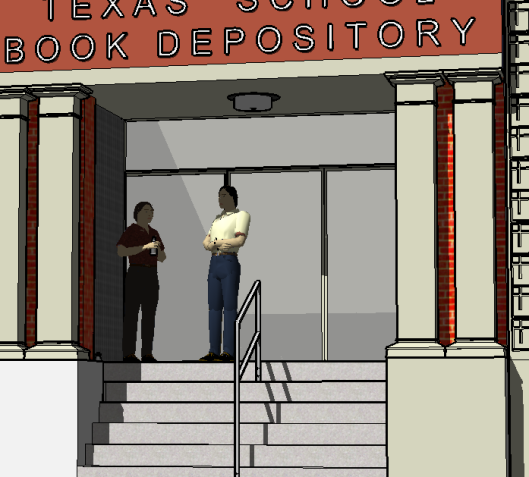
-------------------------------------------------------------------------------------------------------------------------------------------------------------------------------------
Please find here various views of the doorway which illustrate Prayer Man's and Frazier's locations.
Detailed view of Prayer Man and Frazier:

Front view of the doorway:

Through the glass door:

-
Dear Ray:
I confess I have overlooked the corner part of the bottom rail which shows a slightly greater brightness than the rest of the rail. However, does this bit of the rail really mark the shadow line? It can also be a slightly different, maybe stronger, metal plate holding the junction of two rails. If the shadow line would indeed be that far to the right (when viewed from the front), there could not be the bright areas on the steps or on the figure standing on the top landing. The green line in the picture below would correspond to your proposed shadow line. However, the spots delineated by the yellow ellipses would also need to to be in the shadow. The shadow line is actually only a 2D projection of the shadow plane onto the surface of the steps and top landing.
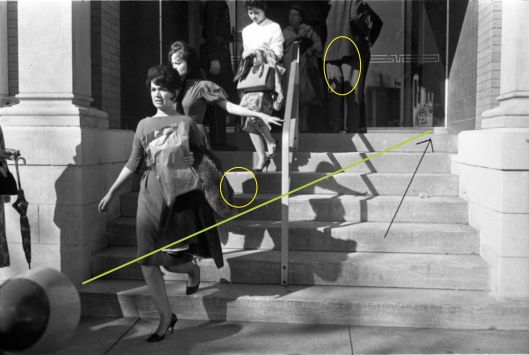
Your idea to get some real doorway photographs with known time of shooting is great. However, the doorway has been rebuilt and unfortunately the dimensions of the top landing do not hold anymore. Thus, I could only comment on the shadows on the steps. It would still be helpful to compare out shadow estimates with template pictures having a time stamp.
I appreciate your comments and ideas on this important issue, The doorway shadows make good service in estimating the locations of different people in the doorway. If not the shadows, the number of possible reconstructions which would equally well represent the doorway scenes in various films or photographs would be just too large.
-
Dear Ray:
Allen's picture showing three ladies leaving the Depository is a great photograph. I think it was taken around 2.10 (maybe even few minutes later), at least my model gives the best match with the picture at about this time. The problem is that the picture does not show the bottom rail of the door frame which makes it difficult to verify both shadow lines, yours as well as mine. Further, human figures, those on steps and also those standing in front of the doorway (and casting their shadows whilst themselves not seen in the picture) also confound the shadows.
Yet, your estimate (green line) appears to be pointing too far towards the eastern (right when viewed from the front) wall. One source of the discrepancies between our estimates may be the quality of the drawing onto which you plot your calculated angles which I am confident are all right. For instance, there are seven steps in the doorway, yet the layout shows only five steps. The top landing appears to be too deep compared to the reality. I assume someone took accurate measures of the Depository and plotted a plan on a sheet of paper, which was then again compressed to fit the size of a book page. If this compressed scheme of the Depository is again enlarged, it may not be as accurate as the original measures.
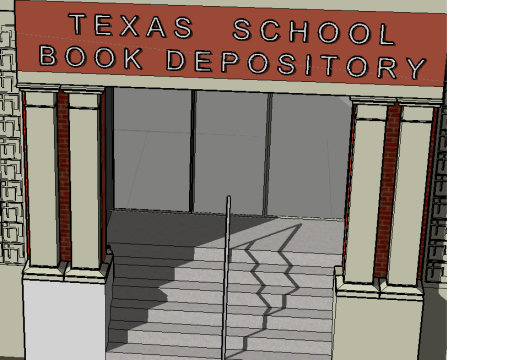
-
Dear Ray:
I have to say that I am not calculating anything to emulate the shadows - the computer does it. The exact geographic location and the location of the sun at any instant is provided by the GoogleEarth program. GoogleEarh and SketchupPro are both produced by Google and therefore linked internally. I have checked the shadows suggested by the Sketchup+GoogleEarth machinery with shadows seen on a number of doorway pictures (Allen, Murray), and found a good match in all cases. It is a bit tricky to verify the shadow produced by the SketchupPro model with Darnell's stills as we do not see the floor shadow in Darnell's stills, only the shadow on the horizontal rail. However, this shadow is a mixture of both the shadow cast by the western wall and the shadow cast by the ceiling. In spite of these limitations (mixed shadows and low signal in this part of the doorway), there is a slight hint even in the Darnell's still that the shadow was actually about 1 foot to west from the vertical door rail. The picture below was also posted at the Reopen Kennedy Case forum a while ago, I hope it is all right to post is on this forum as well. It shows (A) a cut of Darnell's still which does not offer any indication as to where the shadow cast by the western wall would be. In (B-C) the contrasts have been increased in two steps. The C panel shows a transition between a bit brighter and a bit darker part of the rail about a foot away from the vertical rail. In D, the aligned 3D shadow line crossing the bottom horizontal rail is shown. The yellow line crossing all four panels would be the shadow line inferred from ©. I am aware that this reconstruction entails some deliberate contrast operations made with the original picture, however, this is the best I can offer to indicate where the shadow cast by the western wall would be in Darnell's stills. There is a small mismatch between the model and the line obtained by contrasting Darnell's still of about 1 inch.
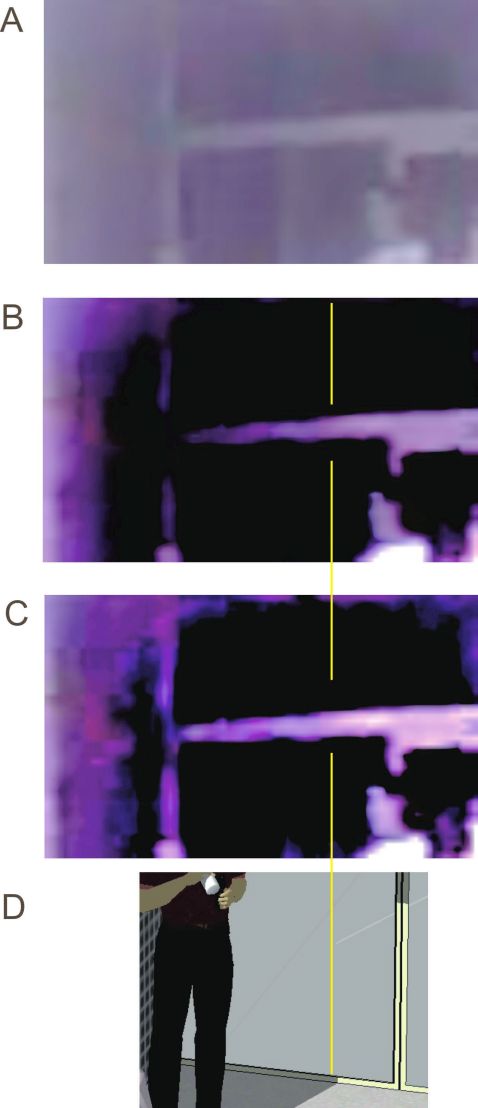
-
Dear Ray:
You may wish to compare your estimate of the shadow cast by the western wall with the 3D reconstructed shadows using SketchupPro program. The figure below shows the shadow which was received by placing the doorway model onto its proper place at the Dealey Plaza and setting the time to 12.31, November 22, any year (estimated time of Darnell's filming). I see the shadow as depicted in your drawing occuring at about 1.05-1.15 (the interval refers to the uncertainty of my reading of the exact position of the shadow relative to the vertical rail of the glass door).The shadow as reconstructed by the SketchupPro model accommodates the possibility of Prayer Man standing close to the western wall with perhaps only the back of his right hand exposed to the sun.

-
I wonder whether all photographs of the bone fragment which have been taken by Dr. Harper (allegedly some 10 pictures) are available for viewing in high quality. If so, it should be possible to make a realistic digital reconstruction of the Harper fragment as a 3D object. This would be unusually helpful for subsequent application of pattern recognition algorithms in which the outer plane of the segment would be digitally superimposed on the high-resolution MR images of the head (voxel size 1x1x1 mm3 or smaller), and the goodness of fit between the Harper fragment and the real head segment at a particular location would be computed for every 3D skull location in every orientation. This procedure would be applied to a large number of human MR images (at least a hundred), which would result in a probabilistic map of a human head (skull) highlighting the region of the skull showing the best (and statistically significant) fit with Harper fragment. I read Dr. Mantik's book, and I also read Mr. Speer's posts, and believe that both gentlemen are honest researchers and high experts. However, sometimes the data may not offer unequivocal solution in which case a statistical solution lends itself as an objective, unbiased approach. It is very likely that Kennedy's skull has been severely damaged prior to the official autopsy (Mr. Lifton's and Mr. Horne's research) meaning that any conclusion based on fitting Harper fragment to the existing X-ray images has a limited validity.
The procedure described here is neither simple nor trivial. I have sufficient number of human head MR data acquired in my previous research studies which could be used (after obtaining a fresh ethics approval for the use of MR images for a different purpose than the purpose of my original research) in this type of analysis. However, extensive programming and time capacity would be necessary. Naturally, the 3D volume rendering of Harper fragment would be the starting point.
-
Dear Tom:
many thanks for your detailed response, I appreciate. After reading how much time you spent and how many notes you made whilst working on these puzzles I was able to understand why you are so comfortable with the ICO puzzles.
I would be grateful if you would check my reasoning in the following example. Let me assume that Oswald did purchase the Mannlicher-Carcano rifle under the assumed name Hidell (I am aware of the ongoing disputes over this issue). He allegedly used a magazine with a large number of adverts, yet he chose one particular advert and one particular rifle. The rifle was a junk and Oswald surely knew it. Maybe the rifle itself was not as important as the particular advert. The advert may have lent itself as a cipher. The advert says:
"6.5 ITALIAN CARBINE," and shows two prices, $12.88 and $19.95. There is also some text in small letters which I assume was used in the puzzle (if it is a puzzle).
Step 1: 65 ITALIAN CARBINE 1995 (I went for the higher price as it gave me more reasonable solutions)
Step 2: changing numbers to letters gives: GFITALIANCARBINETJF
Step 3: unscrambling the long string into words. Three solutions came to my mind. There may be more and better solutions though.
Solution 1: GFITALIANCARBINETJF splits into: xxxx GIANCANE BIT JF FT (not sure what FT could mean) [After posting this message, I noted that the word L I A R was changed by the server to xxxx. Thus, this solution reads: L I A R GIANCANE BIT JF FT].
Solution 2: GFITALIANCARBINETJF can also yield: ALEC FIT JF GIANT BRAIN (changing the order of these words may give different meanings)
Solution 3: GFITALIANCARBINETJF also makes: ALIANCE GIFT JF BRAIN T (this solution I like, however, not sure about the lone T at end).
Maybe it is all too simple and straightforward. I somehow feel that you would not stop here.
Best
Andrej
Edited 16/3: I realised that I mistyped 1995 as 1955 in my original post. I have now corrected 1955 to 1995. The letter conversion was made from 1995 though. Sorry about this inaccuracy - I found at least three different adverts allegedly associated with Hidell's rifle purchase.


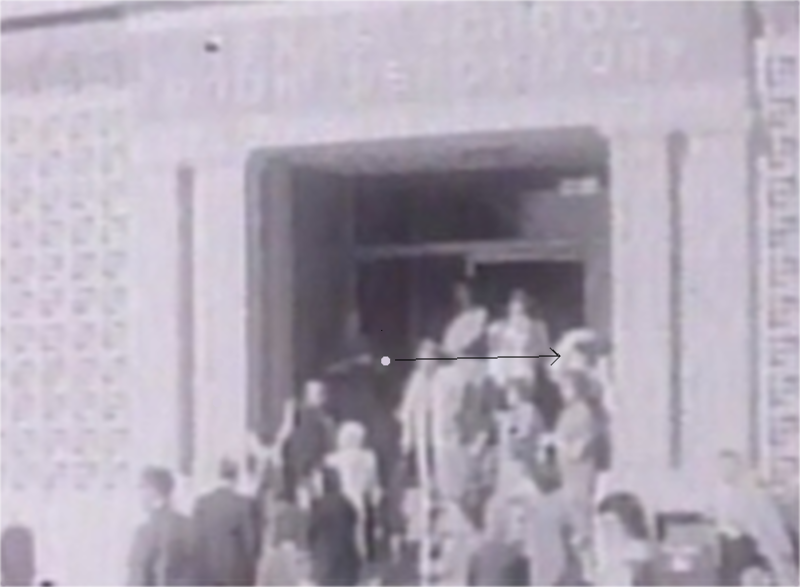
PRAYER PERSON - PRAYER MAN OR PRAYER WOMAN? RESEARCH THREAD
in JFK Research
Posted
Dear Richard,
I look forward to learning your estimate of the doorway depth. Were you able to measure the dimensions of the radiator, of the same radiator which stood in the lobby? If not, your "safe eyeball guess" may lead to a wrong estimate after you apply your formula...
I have commented on how the model was constructed and tested in my response to Ray (157).
As per your comment that I do not realise that my solution does not solve the height question - in a way you are right as I am not using my model to provide the height estimates, I use it to test assumptions (hypotheses). I would also test the model for your hypothesis if you would describe it for me: is it still a lady 5'3''? Does she have a purse in her hands or not? Are there any further details I should take into account when reconstructing her location? Please, let me know - after all, are you not interested to see how your preferred hypothesis would fare if projected in the model?
The pose of PM's left leg is optional. We do not see Prayer Man's legs in Darnell due to some blurred human figures obstructing the view. If you would indicate kindly Prayer Man's posture by tracing contours of his legs, I would be keen to correct the position of his left legs accordingly.
As per the light reflection from the back of Prayer Man's hand: the constrain I applied refers only to the position of Prayer Man's hands, this constrain does not define the location of Prayer Man's body. The location is unequivocally defined by Prayer Man's relation to the corner rail and to the height of Frazier's neck (or the horizontal door rail). These two constrains plus the exact Darnell's view implicate where Prayer Man stood. He stood so close to the shadow line cast by the western wall that his hand was either minimally hit by the sun or received some reflection of nearby objects being fully exposed to the sun. As I have explained in my previous response to Ray, it would be possible to model the position of Prayer Man's hands not to reflect the sun light whilst maintaining Prayer Man's location where he is depicted in the 3-D model.
As per the bottle: I assume that Prayer Man in Darnell was the same person as we see in Wiegman's film, and anyone can see that Prayer Man is lifting his arm as the bright object moves upwards from the prayer posture level towards his head. The likely explanation of the phenomenon is that this man was drinking. If drinking, then the question is from what? I reckon it was a bottle he drank from. And as the person in Wiegman was the same person as we see in Darnell, I have placed a bottle into his hands. You are right it cannot be seen because the picture is too blurred. I can hide the bottle with one click. The bottle in Prayer Man's hands just underlies the continuity between Prayer Man in Wiegman and Darnell. Now, it could be your turn to explain the bright spot around Prayer Man moving in Wiegman. I would be keen to learn what you think is what it only "seems" to be a drinking act. Will we learn your explanation?